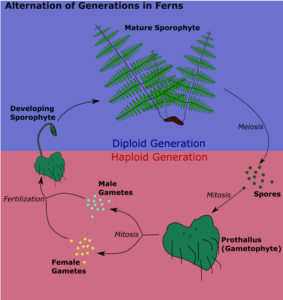Alternation of generations
alternation of generations A life cycle in plants where there is both a multicellular diploid form (the sporophyte generation) and a multicellular haploid form (the gametophyte generation).
Gametophytes produce haploid gametes that fuse zygotes that are forming. These zygotes then develop into diploid sporophytes. Meiosis in the sporophytes produces haploid spores, with division by meiosis giving rise to the next generation of gametophytes.
Alternation of generations occurs in plants and certain species of algae. Ferns and fern allies (such as the club moss) are common examples. The above ground parent fern plant (the diploid sporophyte, or spore-bearing plant) has two full sets of chromosomes (two of each kind of chromosome). It sheds its single-celled haploid spores. Having one set of chromosomes (one of each kind). They fall to the ground, and these in turn grow into a different plant, the gametophyte or prothallus, also haploid.
The gametophyte has special bodies within the plant called archegonia (female cells) and antheridia (male cells). Here sexual fertilization takes place, and a new diploid sporophyte then grows.
There are four main groups of plants that considered to be “fern allies”. A diverse group of vascular plants that are neither flowering plants nor ferns and that reproduce by shedding spore to initiate an alternation of generations. These are the Lycophyta (Lycopsida, the club mosses; Selaginellopsida, the spike mosses; and Isoetopsida, the quillworts); the Archeophyta (Sphenopsida, the horsetails and scouring-rushes; Psilopsida, the whiskbrooms; and Ophioglossopsida, the adder’s-tongues and grape-ferns); the Pteridophyta (ferns); and Spermatophyta (flowering plants).
In some examples of Alternation of generations
for example, in certain algae species such as in some green or brown forms—the alternation of generations takes on two different approaches. Where the sporophytes and gametophytes are structurally different, the two generations are heteromorphic. If the sporophytes and gametophytes look the same and have different chromosome pairs, the generations are said to be isomorphic.





